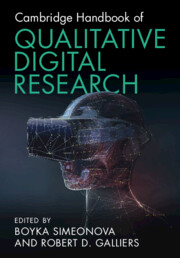Book contents
- Cambridge Handbook of Qualitative Digital Research
- Cambridge Handbook of Qualitative Digital Research
- Copyright page
- Contents
- Figures
- Tables
- Contributors
- Preface
- Part I Philosophical, Epistemological and Theoretical Considerations
- Part II Methodological Considerations
- Part III Illustrative Examples and Emergent Issues
- Chapter 13 Observing Artifacts
- Chapter 14 Algorithms as Co-Researchers
- Chapter 15 Sensemaking about HRV Data of High-Performing Individuals
- Chapter 16 The Rich Facets of Digital Trace Data
- Chapter 17 Balancing the Momentum of Datafication with Qualitative Researchers as Design Thinkers
- Chapter 18 What Data Sharing in Government Tells Us about the Digitalization of Government Services
- Index
- References
Chapter 17 - Balancing the Momentum of Datafication with Qualitative Researchers as Design Thinkers
from Part III - Illustrative Examples and Emergent Issues
Published online by Cambridge University Press: 08 June 2023
- Cambridge Handbook of Qualitative Digital Research
- Cambridge Handbook of Qualitative Digital Research
- Copyright page
- Contents
- Figures
- Tables
- Contributors
- Preface
- Part I Philosophical, Epistemological and Theoretical Considerations
- Part II Methodological Considerations
- Part III Illustrative Examples and Emergent Issues
- Chapter 13 Observing Artifacts
- Chapter 14 Algorithms as Co-Researchers
- Chapter 15 Sensemaking about HRV Data of High-Performing Individuals
- Chapter 16 The Rich Facets of Digital Trace Data
- Chapter 17 Balancing the Momentum of Datafication with Qualitative Researchers as Design Thinkers
- Chapter 18 What Data Sharing in Government Tells Us about the Digitalization of Government Services
- Index
- References
Summary
This chapter introduces the concept of ‘datafication momentum’, which is the tendency for datafication systems to receive more influence from social systems in their early stages and exert more influence on social systems in their mature stages. Due to datafication momentum, datafication systems are prone to be inscribed with the dark side of social systems in their earlier stages, and then amplify this dark side in their later stages (e.g., leading to outcomes like data-driven discrimination). The chapter calls on qualitative researchers to combat this risk with a ‘qualitative researchers as design thinkers’ mindset. In particular, it proposes ‘design forensics’ as a practice in which qualitative researchers integrate design-thinking principles with design ethnography to identify the risk of datafication and shape it to a more desirable end. The chapter introduces three design principles – empathetic datafication, datafication totality and reflective criticism – and discusses their implications for research and practice.
Keywords
- Type
- Chapter
- Information
- Cambridge Handbook of Qualitative Digital Research , pp. 268 - 281Publisher: Cambridge University PressPrint publication year: 2023



